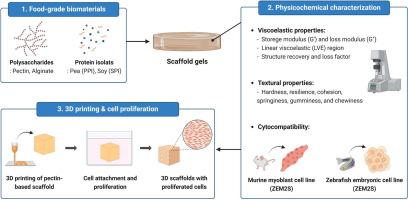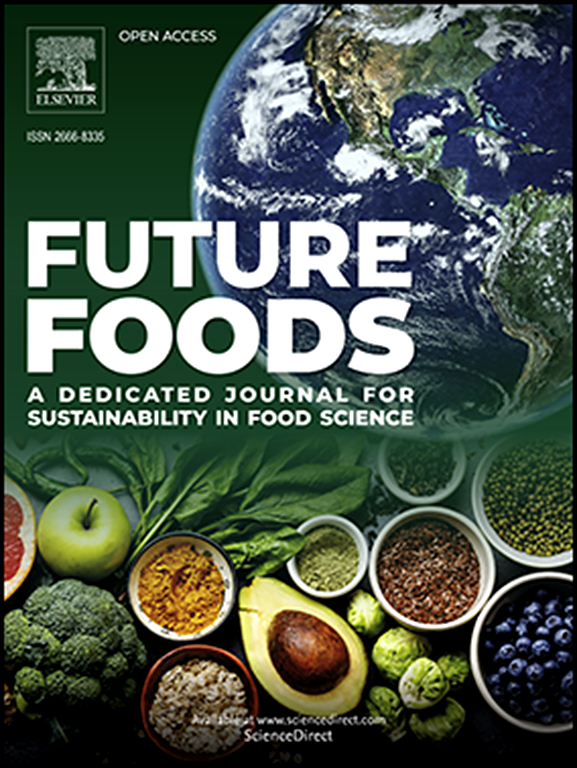作为细胞农业支架的植物基生物材料
IF 7.2
Q1 FOOD SCIENCE & TECHNOLOGY
引用次数: 0
摘要
可食用支架是培育肉类的重要成分。本研究旨在评估食品级多糖(果胶和海藻酸)和蛋白质(大豆分离蛋白(SPI)和豌豆分离蛋白(PPI))作为培养肉生产支架的性能。选择了一种肌母细胞模型细胞系(C2C12)和一种胚胎衍生鱼细胞系(ZEM2S)作为模型细胞系。流变学分析表明,所选凝胶是具有剪切稀化行为的粘弹性固体。果胶和 PPI 的储存模量(G')和损耗模量(G'')分别大于 1000 Pa 和 100 Pa。与其他生物聚合物凝胶相比,果胶凝胶具有更好的结构恢复性。其质地特性与商用肉类类似物相似。此外,果胶凝胶在水中也很稳定。总的来说,生物材料凝胶的细胞相容性与测试的细胞系相似,但 ZEM2S 在接触蛋白质凝胶时除外。根据凝胶的机械性能和细胞相容性结果,生成了含有果胶凝胶的三维打印结构。在 5 天的培养过程中,三维打印支架促进了 C2C12 细胞的增殖。这些发现凸显了植物生物材料和三维打印技术在开发培养肉生产支架方面的潜力。本文章由计算机程序翻译,如有差异,请以英文原文为准。

Plant-based biomaterials as scaffolds for cellular agriculture
Edible scaffolds are the essential components for cultivated meat. This research aimed to evaluate the performance of food-grade polysaccharides (pectin and alginate) and proteins (soy protein isolate (SPI) and pea protein isolate (PPI)) as scaffolds for cultivated meat production. A myoblast model cell line (C2C12) and an embryonic-derived fish cell line (ZEM2S) were selected as model cell lines. Rheological analysis revealed that the selected gels were viscoelastic solids with shear thinning behavior. The storage modulus (G') and loss modulus (G'') of pectin and PPI were greater than 1000 Pa and 100 Pa. The pectin gels exhibit better structure recovery compared to other biopolymer gels. The texture properties were similar to those of commercial meat analogues. Furthermore, the pectin gels were stable in water. In general, the cytocompatibility of the biomaterial gels was similar for the tested cell lines, except for ZEM2S when exposed to protein gels. Based on the results of mechanical properties and cytocompatibilities of gels, a 3D printed structure with pectin gel was generated. 3D-printed scaffolds promoted the proliferation of C2C12 cells during 5 days of incubation. These findings highlight the potential of plant biomaterials and 3D printing to develop scaffolds for the production of cultivated meat.
求助全文
通过发布文献求助,成功后即可免费获取论文全文。
去求助
来源期刊

Future Foods
Agricultural and Biological Sciences-Food Science
CiteScore
8.60
自引率
0.00%
发文量
97
审稿时长
15 weeks
期刊介绍:
Future Foods is a specialized journal that is dedicated to tackling the challenges posed by climate change and the need for sustainability in the realm of food production. The journal recognizes the imperative to transform current food manufacturing and consumption practices to meet the dietary needs of a burgeoning global population while simultaneously curbing environmental degradation.
The mission of Future Foods is to disseminate research that aligns with the goal of fostering the development of innovative technologies and alternative food sources to establish more sustainable food systems. The journal is committed to publishing high-quality, peer-reviewed articles that contribute to the advancement of sustainable food practices.
Abstracting and indexing:
Scopus
Directory of Open Access Journals (DOAJ)
Emerging Sources Citation Index (ESCI)
SCImago Journal Rank (SJR)
SNIP
 求助内容:
求助内容: 应助结果提醒方式:
应助结果提醒方式:


